 |
||
|
||
| ||
On the future of x86 64-bit extensions Photo of the day: HIS VT Book CardBus DVI graphics adapter in our lab iomega Micro Mini USB 2: smaller and smaller On the future of x86 64-bit extensions The key event of IDF Spring 2004 was the offcially announced support of 64-bit extensions in the future Intel´s IA32 desktop, server, and mobile processors. Before the official announcement this technology was codenamed Yamhill, but after that obtained the more sonorous name, Clackamas Technology. Specialists however prefer calling it IA32E. Despite that Intel´s key plans regarding IA32E are generally specified and declared, there are at least two issues remaining unclear: When should we actually see Intel IA32E desktop processors? And to what extent are these IA32 64-bit extensions similar in versions from Intel and AMD? In fact, there are much more questions, but since two companies are going to use their respective IA32E and AMD64 extensions on at least one common product, namely Windows XP 64-bit Edition, all other questions are rather secondary and somehow intertwined with aforementioned two key issues. In one of our first reports from IDF Spring 2004 we shed some light on the speech of Craig Barrett and informed you that Intel will introduce 64-bit extensions for Prescott models closer to the year-end. (Personally, I guess that Clackamas Technology will occupy a lion´s share of time at IDF Fall 2004 in September). It´s actually unimportant which core, Prescott or Tejas, will be the first to support IA32E — it will happen in time of LGA775 anyway. Another matter is that IA32E processors that will enter the market this year will hardly be related to usual desktop solutions. Judging by Intel´s declarations there´s a clear plan of advancing Clackamas Technology primarily to the server market into Nocona core to spite AMD´s Opteron series. As for the IA32E support by desktop solutions, I think Intel´s position was most clearly shown not at IDF presentation, but a day later, during the interview of William Siu, Vice President, General Manager, Desktop Platforms Group, granted to Reuters. According to his opinion, the new 64-bit technology won´t be required in desktop PCs until about 2006. This doens´t mean that Intel will delay IA32E launch until 2006. Intel is just going to act when the aggregate of all components, including operating system and software will be ready to support these extensions. Here´s the key phrase of William Siu expressing Intel´s current attitude to implementing IA32E into desktop platforms:
In other words, Intel believes these 64-bit extensions won´t be required until there´s supporting software, e.g. Microsoft Windows Longhorn, expected late in 2005 or even early in 2006. Frankly speaking, such position seems weighted and solid, but still perplexes. Recently the new platform features were being implemented independently on the need of end users. There´s a lot of examples to this, and I think desktops might have bypassed some intermediate CPU form-factors or AGP 8X bus. The industry might have normally jumped from AGP 4x to PCI Express at once. Still, it´s another thing that matters. Today AMD is exhibited some light-mindedly with its 64-bit instructions in "desktop" Athlon 64, having realized AMD64 in silicon, but haven´t provided the necessary software support. On the other hand, AMD64 is actually almost free of charge in today chips, being such a free option of 32-bit processors. But if needed 64-bit features are available (for at least looking at) already now in 64-bit Windows or in some Linux clone. By Autumn, when Windows XP 64-bit Edition beta is to be transformed into the final version, the market will have some more commercialized software for this platform. By that time AMD64-supporting camp will number millions or even tens of millions of PCs. Besides, don´t forget that the capability of working under Windows XP 64-bit Edition will energize software makers that will start porting their soft under the new platform. Summing everything up, I´d like to remember times when Opteron/Athlon 64 family was named merely Hammer and existed only on paper. That ime AMD was claimed for evolutionary approach to the transition to 64-bit applications. It hasn´t changed since, being promoted to the extent of finances. It´s now clear that the idea of evolutionary transition was successful. And it´s obviously good that Intel and AMD are now moving in the same direction, so users won´t be confused with determining the kind of their IA32+ processors when purchasing 64-bit Windows in the future. [I guess Bill Gates should be glad that his desktop monopoly remained unshattered ;)]. And now in brief about the second question about the similarity of Intel´s and AMD´s IA32 64-bit extensions. Published Intel IA32E specs, in particular, "64-Bit Extension Technology Software Developer´s Guide" allows for a more or less clear answer. Let´s consider all possible work modes of a IA32E processor. 64-bit applications under a 64-bit OS will require full 64-bit mode, while the "compatible submode" provides binary compatibility with 16/32-bit applications. This makes IA32E fully identical to the so-called Long Mode of AMD64.
IA32E support is controlled by Extended Feature Enable MSR (IA32_EFER), similar to EFER control bit of AMD64. When LMA = 0, the chip works as a usual x86 CPU (Legacy Mode), while at LMA = 1 it works in 64-bit IA32E mode.
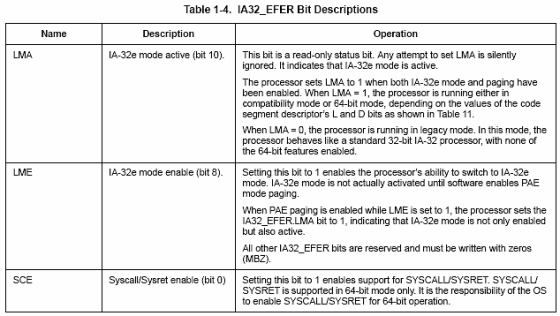 Now let´s look at the 64-bit mode:
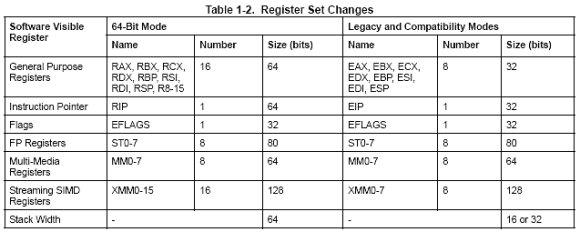 When the Clackamas Technology mode is enabled, the processor starts supporting 64-bit addressing, however pagewise, as its address space is limited to 52 bits. The existing processors can address up to 48-bit of virtual address space, while the physical address length is limited to 40 bits. Therefore in total, the processor can address up to a terabyte of memory. Besides, the 64-bit mode adds 8 new 64-bit GPR registers with R prefix; 8 new registers, XMM8 to XMM15, supporting SSE, SSE2, SSE3; and 64-bit RIP pointers. So, it´s virtually fully identical to AMD64. Of course, if you dig into the docs, you can find some more peculiarities of IA32E that, if needed, can be used to limit the platforms compatibility in the future. There´s still the difference — don´t forget about the absence of SSE3 and Hyper-Threading in the existing AMD64 chips. However, the key fact is that the compatibility can be provided without excessive efforts. It just depends on software maker. Finishing this long news, I´d like to mark that whatever the fate of 64-bit extensions is, we, end users, should be glad that x86 software platform will remain unified. This is quite a lot anyway...
Photo of the day: HIS VT Book CardBus DVI graphics adapter in our lab Recently Hightech Information System (HIS) has introduced an interesting graphics adapter, VT Book, providing additional DVI connector for notebooks with CardBus support. Today we are glad to introduce you its first photos from our lab. VT Book can be used with any PC working under Windows 2000/XP or MacOS 9.2.2/10.2.8 that features 32-bit CardBus interface (PC Card Type II slot). Inside the adapter is graphics controller on Trident XP2 chip and 32MB DDR266. The adapter supports resolutions up to 1920x1200 @ 85Hz via DVI-I and up to 1280x1024 @ 100Hz via optional DVI-VGA adapter. Sized 126x54x15mm, the novelty weighs 68g. The bundle might also include optional ADC adapter for Macs. VT Book´s peak energy consumption doesn´t exceed 3W.
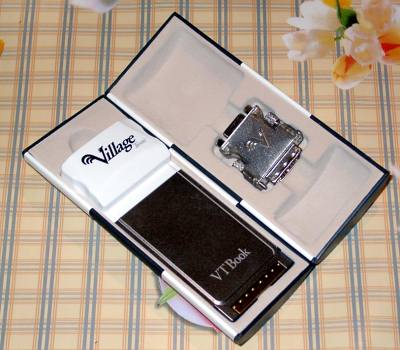 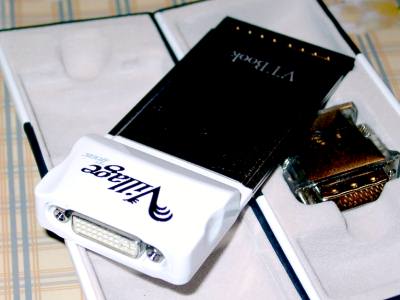 iomega Micro Mini USB 2: smaller and smaller iomega released and launched shipments of its Micro Mini USB 2.0 Flash dongle. It´s actually one of the smallest devices of its class. Sized just 17.5x9.5x38.1mm, it weighs just 9g. The company introduced 64MB and 128MB models (the latter will go on sale in April).
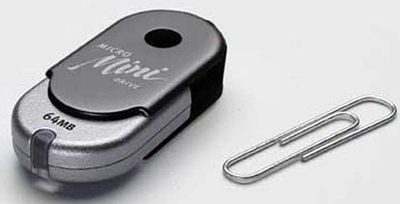 Besides, iomega introduced Mini USB 2.0 products that don´t differ much from similar devices, just by a special holder for a small photo or something like that. The series includes 256MB and 512MB models. The former will go on sale on February 26. This seems interesting expecially consedering that 512MB model went on sale today. In general this series will include 128, 256, 512 MB and 1 GB products. Sized 25.9x13.7x87.1mm, a dongle weighs 21.6g.
 Source: PC Watch
Write a comment below. No registration needed!
|
Platform · Video · Multimedia · Mobile · Other || About us & Privacy policy · Twitter · Facebook Copyright © Byrds Research & Publishing, Ltd., 1997–2011. All rights reserved. | ||||||||||||||||||||||||||||||||||||||||||||||||||||||||||||||||||||||||||||||||||||||||||